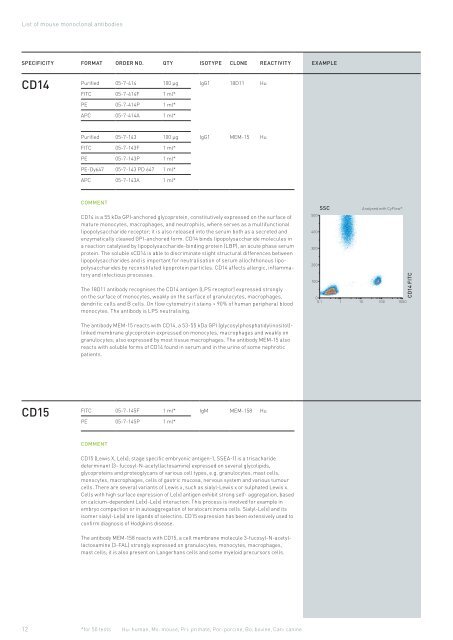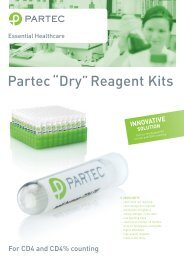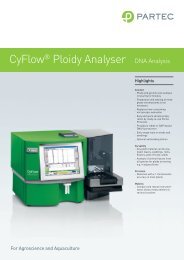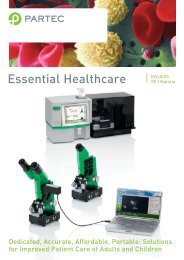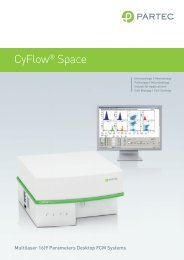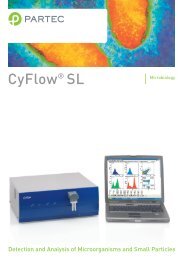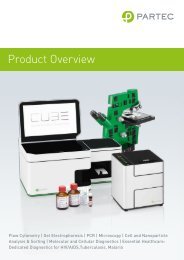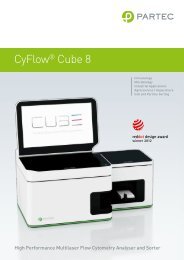Partec Reagents & mAb Catalog
Partec Reagents & mAb Catalog
Partec Reagents & mAb Catalog
You also want an ePaper? Increase the reach of your titles
YUMPU automatically turns print PDFs into web optimized ePapers that Google loves.
List of mouse monoclonal antibodies<br />
sPecificity format order no. Qty isotyPe clone reactivity examPle<br />
cd14 Purified 05-7-414 100 µg IgG1 18D11 Hu<br />
FITC 05-7-414F 1 ml*<br />
PE 05-7-414P 1 ml*<br />
APC 05-7-414A 1 ml*<br />
Purified 05-7-143 100 µg IgG1 MEM-15 Hu<br />
FITC 05-7-143F 1 ml*<br />
PE 05-7-143P 1 ml*<br />
PE-Dy647 05-7-143 PD 647 1 ml*<br />
APC 05-7-143A 1 ml*<br />
comment<br />
CD14 is a 55 kDa GPI-anchored glycoprotein, constitutively expressed on the surface of<br />
mature monocytes, macrophages, and neutrophils, where serves as a multifunctional<br />
lipopolysaccharide receptor; it is also released into the serum both as a secreted and<br />
enzymatically cleaved GPI-anchored form. CD14 binds lipopolysaccharide molecules in<br />
a reaction catalysed by lipopolysaccharide-binding protein (LBP), an acute phase serum<br />
protein. The soluble sCD14 is able to discriminate slight structural differences between<br />
lipopolysaccharides and is important for neutralisation of serum allochthonous lipopolysaccharides<br />
by reconstituted lipoprotein particles. CD14 affects allergic, inflammatory<br />
and infectious processes.<br />
The 18D11 antibody recognises the CD14 antigen (LPS receptor) expressed strongly<br />
on the surface of monocytes, weakly on the surface of granulocytes, macrophages,<br />
dendritic cells and B cells. On flow cytometry it stains > 90% of human peripheral blood<br />
monocytes. The antibody is LPS neutralising.<br />
The antibody MEM-15 reacts with CD14, a 53-55 kDa GPI (glycosylphosphatidylinositol)linked<br />
membrane glycoprotein expressed on monocytes, macrophages and weakly on<br />
granulocytes; also expressed by most tissue macrophages. The antibody MEM-15 also<br />
reacts with soluble forms of CD14 found in serum and in the urine of some nephrotic<br />
patients.<br />
cd15 FITC 05-7-145F 1 ml* IgM MEM-158 Hu<br />
PE 05-7-145P 1 ml*<br />
comment<br />
CD15 (Lewis X, Le(x); stage specific embryonic antigen-1, SSEA-1) is a trisacharide<br />
determinant (3- fucosyl-N-acetyllactosamine) expressed on several glycolipids,<br />
glycoproteins and proteoglycans of various cell types, e.g. granulocytes, mast cells,<br />
monocytes, macrophages, cells of gastric mucosa, nervous system and various tumour<br />
cells. There are several variants of Lewis x, such as sialyl-Lewis x or sulphated Lewis x.<br />
Cells with high surface expression of Le(x) antigen exhibit strong self- aggregation, based<br />
on calcium-dependent Le(x)-Le(x) interaction. This process is involved for example in<br />
embryo compaction or in autoaggregation of teratocarcinoma cells. Sialyl-Le(x) and its<br />
isomer sialyl-Le(a) are ligands of selectins. CD15 expression has been extensively used to<br />
confirm diagnosis of Hodgkins disease.<br />
The antibody MEM-158 reacts with CD15, a cell membrane molecule 3-fucosyl-N-acetyllactosamine<br />
(3-FAL) strongly expressed on granulocytes, monocytes, macrophages,<br />
mast cells; it is also present on Langerhans cells and some myeloid precursors cells.<br />
12 *for 50 tests Hu: human, Ms: mouse, Pri: primate, Por: porcine, Bo: bovine, Can: canine<br />
500<br />
400<br />
300<br />
200<br />
100<br />
ssc Analysed with CyFlow ®<br />
fitc cd14<br />
0<br />
0.1 1 10 100 1000


